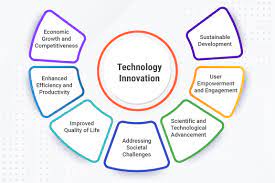The Importance of Research and Development (R&D) Strategy in Driving Innovation
Research and Development (R&D) strategy plays a crucial role in the success and growth of companies across various industries. By investing in R&D, organisations can drive innovation, stay competitive, and meet the evolving needs of their customers. In this article, we explore the significance of R&D strategy and how it influences business success.
What is R&D Strategy?
R&D strategy refers to a planned approach that organisations adopt to conduct research activities aimed at developing new products, services, or processes. It involves allocating resources, setting goals, and defining methodologies to foster innovation and drive growth. A well-defined R&D strategy enables companies to explore new opportunities, improve existing offerings, and maintain a competitive edge in the market.
The Benefits of an Effective R&D Strategy
Innovation: R&D strategy fuels innovation by encouraging experimentation and exploration of new ideas. It allows companies to create cutting-edge products or services that differentiate them from competitors and attract customers.
Competitive Advantage: Companies that invest in R&D gain a competitive advantage by staying ahead of market trends and technological advancements. By continuously improving their offerings through research, they can meet customer demands more effectively.
Growth Opportunities: An effective R&D strategy opens up new growth opportunities for businesses. By investing in research activities, companies can identify untapped markets, develop breakthrough solutions, and expand their reach.
Implementing an R&D Strategy
To implement a successful R&D strategy, organisations should consider the following key steps:
- Set Clear Objectives: Define specific goals for your research activities that align with your overall business objectives.
- Allocate Resources Wisely: Allocate sufficient resources – including funding, talent, and time – to support your R&D initiatives effectively.
- Foster Collaboration: Encourage collaboration between different departments within your organisation to leverage diverse expertise and insights.
- Embrace Risk-Taking: Embrace a culture that values experimentation and risk-taking to drive innovation and creativity within your team.
The Future of R&D
In today’s rapidly evolving business landscape, organisations must continue to prioritise R&D as a key driver of success. By investing in research activities, embracing emerging technologies such as artificial intelligence (AI) and machine learning (ML), and fostering a culture of innovation, companies can position themselves for long-term growth and sustainability.
In conclusion, an effective R&D strategy is essential for companies looking to innovate, grow, and thrive in an increasingly competitive market environment. By making strategic investments in research activities and fostering a culture of creativity within their teams, organisations can unlock new possibilities and drive sustainable success.
8 Essential Tips for Crafting an Effective R&D Strategy
- 1. Clearly define your research goals and objectives.
- 2. Allocate sufficient resources for R&D activities.
- 3. Foster a culture of innovation within your organisation.
- 4. Stay informed about industry trends and technological advancements.
- 5. Collaborate with external partners, such as universities or research institutions.
- 6. Protect your intellectual property through patents or other means.
- 7. Continuously evaluate and adjust your R&D strategy based on results and feedback.
- 8. Encourage cross-functional collaboration among different departments.
1. Clearly define your research goals and objectives.
To ensure the effectiveness of your Research and Development (R&D) strategy, it is crucial to clearly define your research goals and objectives. By establishing specific and measurable targets, organisations can focus their efforts on areas that align with their overall business vision. Clear research goals provide a roadmap for innovation, guiding R&D activities towards the development of products, services, or processes that meet the needs of customers and drive growth. Defining research objectives also helps in evaluating the success of R&D initiatives and enables companies to make informed decisions about resource allocation and future directions.
2. Allocate sufficient resources for R&D activities.
Allocating sufficient resources for Research and Development (R&D) activities is crucial to the success of any organisation’s innovation efforts. By dedicating appropriate funding, talent, and time to R&D initiatives, companies can effectively support the exploration of new ideas, development of innovative solutions, and continuous improvement of products and services. Adequate resources enable teams to conduct in-depth research, experiment with different approaches, and ultimately drive meaningful outcomes that propel the business forward in a competitive market landscape.
3. Foster a culture of innovation within your organisation.
To enhance your Research and Development (R&D) strategy, it is crucial to foster a culture of innovation within your organisation. By encouraging creativity, experimentation, and openness to new ideas, you can inspire your team to think outside the box and explore innovative solutions. Embracing a culture that values innovation not only boosts employee morale and engagement but also cultivates a dynamic environment where breakthrough ideas can thrive. This approach helps drive continuous improvement, fuels creativity, and positions your organisation at the forefront of technological advancements and market trends.
4. Stay informed about industry trends and technological advancements.
To enhance the effectiveness of your Research and Development (R&D) strategy, it is crucial to stay informed about industry trends and technological advancements. By keeping abreast of the latest developments in your industry, you can identify emerging opportunities, anticipate market shifts, and align your R&D efforts with future demands. Proactively monitoring industry trends and technological advancements enables you to adapt quickly, innovate strategically, and maintain a competitive edge in today’s fast-paced business environment.
5. Collaborate with external partners, such as universities or research institutions.
To enhance your Research and Development (R&D) strategy, consider collaborating with external partners, such as universities or research institutions. By partnering with these external entities, you can tap into their expertise, resources, and networks to drive innovation and accelerate the development of new products or services. Collaborations with universities and research institutions can bring fresh perspectives, access to cutting-edge technologies, and opportunities for joint research projects that can lead to groundbreaking discoveries. Embracing external partnerships in your R&D strategy can help you stay at the forefront of industry advancements and foster a culture of continuous innovation within your organisation.
6. Protect your intellectual property through patents or other means.
To safeguard the fruits of your Research and Development (R&D) efforts, it is crucial to protect your intellectual property through patents or other means. By securing patents for your innovative products, processes, or technologies, you can establish exclusive rights and prevent competitors from replicating your creations. This not only safeguards your investments in R&D but also gives you a competitive advantage in the market, enabling you to capitalise on your unique innovations and maintain a strong position in your industry.
7. Continuously evaluate and adjust your R&D strategy based on results and feedback.
It is essential to continuously evaluate and adjust your Research and Development (R&D) strategy based on results and feedback to ensure its effectiveness. By regularly assessing the outcomes of your research activities and gathering feedback from stakeholders, you can identify areas for improvement, refine your approach, and align your strategy with changing market dynamics. This iterative process allows companies to stay agile, responsive, and proactive in driving innovation and achieving their business objectives through R&D initiatives.
8. Encourage cross-functional collaboration among different departments.
Encouraging cross-functional collaboration among different departments is a key tip in developing a successful Research and Development (R&D) strategy. By fostering communication and cooperation between teams with diverse expertise, organisations can leverage a wide range of perspectives and skills to drive innovation. This collaborative approach not only enhances creativity and problem-solving but also ensures that research initiatives are aligned with overall business objectives. Ultimately, cross-functional collaboration facilitates the sharing of knowledge, accelerates the development process, and leads to more effective outcomes in R&D projects.





